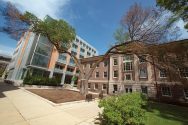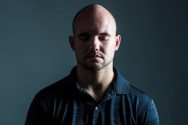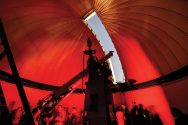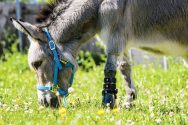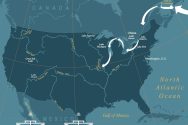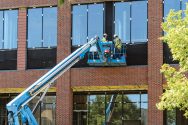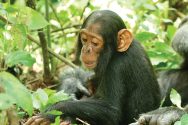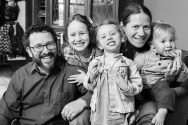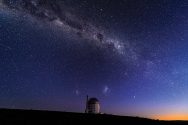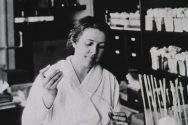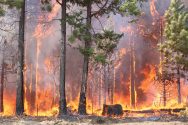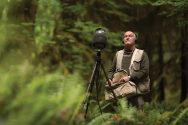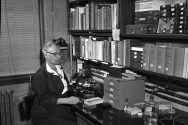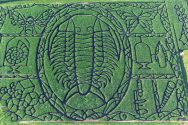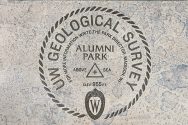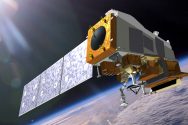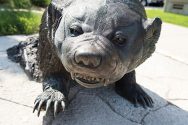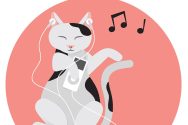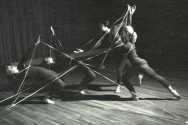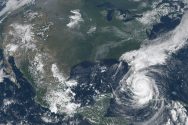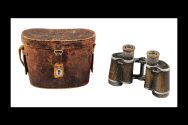Dutch elm disease claims Elmer, a campus tree more than a century old that stood outside the Hector F. DeLuca Biochemistry Building.
Science
280 stories. Showing page 4 of 10.
Chris Borland ’13 did the unthinkable: he abruptly retired from the NFL, bringing the unseen dangers of the sport to the forefront.
With shovels in tow, a UW program is tackling two crises at once: a shortage of students in science and a growth of antibiotic resistance.
Stargazers take in a nighttime view using the observatory’s vintage telescope. Washburn hosts regular public observing sessions and posts its schedule on Twitter. Built in 1881, the observatory was a gift to the UW from former Wisconsin Governor Cadwallader Washburn, who directed that the 15.6-inch telescope lens be…
Bryce Richter
Ferguson the miniature donkey got a hand — actually a leg — from the School of Veterinary Medicine recently to replace a deformed hoof. The procedure was a first for the UW’s large animal hospital: amputation with a prosthesis is complex and rare for…
How zebra and quagga mussels native to the Caspian Sea came to wreak environmental havoc in the Great Lakes and beyond.
Bryce Richter
Major projects are under way on the UW–Madison campus to remove bottlenecks for students who need access to chemistry classes to graduate, modernize campus dairy operations, and make more room for meat science teaching and research.
Chemistry building expansion and renovationAfter a UW scientist and his wife lost two pregnancies, he sought answers. Why are these losses so common, and do other living things face the same struggle his family did?
UW researchers are using drones to search for more sustainable farming methods.
UW–Madison’s Arboretum is part of a nationwide effort to protect the popular insect.
UW–Madison researchers in South Africa are at the heart of work that is unraveling the mysteries of the universe, determining when and how life on Earth began, and identifying the origins of humankind. A team from University Communications — videographer Justin Bomberg ’94, photographer Jeff Miller, and science writer…
Meet a Badger who made one of the most important contributions to public health in the 20th century.
Erik Iverson calls himself the consummate outsider: he is not a UW–Madison alumnus and he’s not from Wisconsin. But in 2016, he became the managing director for the Wisconsin Alumni Research Foundation (WARF), which helps UW researchers take their discoveries to the marketplace. Since then, Iverson has…
Can we have class outside today? Environmental science students enjoy the environment on a spring day in 2017. Science Hall houses the Nelson Institute for Environmental Studies — when it’s not outdoors.
Photo by Jeff Miller…
Researcher Eloise Gerry blazed a trail for female scientists during her four decades with the U.S. Forest Products Laboratory in Madison. Photo courtesy of USDA Forest Service, Forest Products Laboratory, Madison
I always knew my children would be smarter than me — I just didn’t expect…
In Alaska, where glaciers are melting, Fran Ulmer ’69, JD’72 leads a commission tasked with helping U.S. officials decide what to do about climate change.
Photo by Angie Treinen
Angie Treinen ’88, DVM’93 received a novel idea this year from the UW’s Geology Museum for her family farm’s award-winning corn maze: a giant trilobite. The now-extinct marine creature — and the state’s official fossil — once cruised the planet’s seas, including those…
When the Wisconsin Alumni Association opened Alumni Park in October, it offered more than a green space on the Lake Mendota shoreline. It also included dozens of exhibits that feature hundreds of UW alumni and the things they’ve done to leave a mark on the world. Tucked in…
Suomi NPP satellite
Named after Verner Suomi, who founded the UW’s renowned Space Science and Engineering Center in 1965 and is often called the father of satellite meteorology…
Badgers have made their mark on Antarctica, thanks to the UW’s long history of research and exploration of the continent.
From scientific marvels to meaningful mementos, items found in the offices of UW professors help tell their stories.
The collection spans a full century of work from multiple sculptors, and is just a small portion of the more than 100 pieces of public art that bring color to campus.
The UW’s ideas factory churns out remarkable findings that don’t always get the notoriety they deserve.
From the beginning, the UW has been a higher education pioneer in research, education, and innovation.
UW Archives is home to items that belonged to the ecologist who became the most influential conservation thinker of the 20th century.
